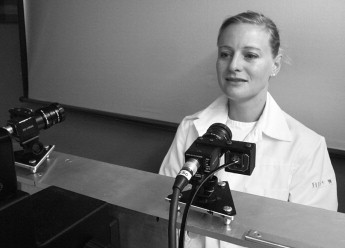Introduction
The aim of this study was to investigate a new digital 3-dimensional infrared video system to determine its accuracy, precision, and validity in measuring facial distances.
Methods
Bench experiments were performed by measuring the vertical and diagonal distances of chessboard squares of known length to determine the system’s accuracy and precision. To test the system’s validity, 16 healthy volunteers participated in this study. Vertical and horizontal distances of the face were measured electronically at rest, and on posed and aggressive smiles. All measurements were repeated after 8 weeks. Direct measurements of the intercanthal distance were obtained twice with calipers.
Results
A minor systematic error was found in the bench experiments, with the highest absolute error of 0.227 ± 0.39 mm. The analysis with this video system showed good reproducibility of all measured distances when the mean of 2 frames was used to compare distances. Digital measurements of the intercanthal distances showed high agreement with the clinically obtained values.
Conclusions
This digital video system can measure geometric distances in a 3-dimensional environment with high precision. Facial distances can be measured with good accuracy and precision, allowing applications in research and clinical practice.
Editor’s comment
The objective assessment of facial features and facial mobility in orthodontics allows evaluations of some aspects of craniofacial diseases and assessments of treatment outcomes. Characterizing the mimic muscles in function can be useful for patients with facial motor deficits such as cleft lip and palate. Orthognathic surgical treatment can significantly influence the cranial hard-tissue structures and cause adaptions of facial musculature. Until recently, researchers analyzed patient photographs in 2 dimensions or by interpositioning 2 photographs in 3 dimensions (2D and 3D photogrammetry). The purpose of this study was to evaluate a new digital 3-dimensional (3D) infrared-based video system by testing the hypotheses: the system measures geometric distances under bench and clinical conditions with high accuracy (veracity) and precision (reproducibility), and opto-electronically obtained intercanthal distances correspond to the values obtained with calipers under clinical conditions (validity).
The complete description of this methodology is lengthy and detailed, so you will want to read the entire article online if you are inspired to learn more. The authors invested much time and effort to complete this meticulous study. They have shown that the SmartEye system can measure 3D distances with high reproducibility without marking landmarks on the patient’s face, as required for some other video systems. Thus, the possible impairment of facial movement when markers are attached to the skin is avoided. Furthermore, traumatized and impaired patients can be examined without an uncomfortable, lengthy, and complicated preparation period for the recordings.
These results confirm the hypotheses and validate the SmartEye System for clinical and research purposes. The values for the intercanthal distances correspond to the values obtained with calipers under clinical conditions. The system’s accuracy and validity are adequate to allow comparisons with normative databases.





